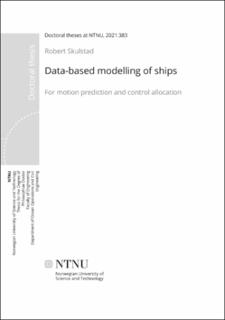| dc.contributor.advisor | Zhang, Houxiang | |
| dc.contributor.advisor | Fossen, Thor I. | |
| dc.contributor.advisor | Vik, Bjørnar | |
| dc.contributor.author | Skulstad, Robert | |
| dc.date.accessioned | 2021-12-02T09:55:42Z | |
| dc.date.available | 2021-12-02T09:55:42Z | |
| dc.date.issued | 2021 | |
| dc.identifier.isbn | 978-82-326-6605-8 | |
| dc.identifier.issn | 2703-8084 | |
| dc.identifier.uri | https://hdl.handle.net/11250/2832524 | |
| dc.description.abstract | Vessels operating on the surface of the ocean are exposed to an array of disturbances. These may come in terms of environmental disturbances, but may also come from signal loss. Modelling the behaviour of ships using physics-based models have therefore been pursued extensively to accommodate improved state estimation and motion control. These models map inherent ship motion states such as speed, heading, acceleration, wind effects and thruster forces from one discrete time step to the next (assuming equal measurement frequency). As such they are one-step predictors that enhance our understanding of the vessel motion. With the increased focus on autonomous ships recently there is a growing need for technology that allows for extending, or projecting this window into the future. The aim of such a system is to supply a glimpse of the near-future trajectories to aid both the ship operator (autonomous ship operating system, or human ship operator) and operators at onshore remote control centres to get a better situational understanding. Ultimately this would lead to safer, and potentially more efficient, operations. The need for such a system is not ever-present. Thus a few scenarios were highlighted, which involve maneuvering in areas populated by other vessels (docking operation) and stationkeeping in proximity of fixed installations (power failure or position reference failure). To verify the benefit of including data-driven models for the aforementioned cases, ship simulators and historical data from the research vessel Gunnerus was applied. For the docking and power failure scenarios, the combined use of the identified maneuvering model and a neural network model was proposed. The, now hybrid, model was trained in a supervised fashion on relevant motion-related data. This lead to increased prediction performance compared to applying just the identified maneuvering model. Low-speed maneuvering and stationkeeping are operational modes typically associated with ships that perform specialized tasks such as the research vessel Gunnerus that support the use of remotely operated vehicles and autonomous underwater vehicles. Other operations that require such operational modes include deploying subsea installations and pipeline installation and maintenance. To ensure safety and maneuvering capability the vessels used in these operations have redundancy in terms of thrusters and power generators. Having a redundant set of thrusters suggests that there are more than one set of thruster commands that may fulfill the overall motion controller request. The control allocation thus distributes thruster commands to ensure that the motion controller requests are met, but also that the commands honor inherent thruster constraints and leads to a minimized power consumption. The resulting optimization problem may be quite complex to solve because of the mentioned constraints. In this thesis a neural network was applied to yield an efficient evaluation of the mapping between the motion controller requests and individual thruster commands. To facilitate optimization within the bounds of the constraints of the system, custom loss functions were applied. They provide a metric for the performance of the network and this is subsequently used to shape the response of the network during an initial offline training period. When training has completed the thruster commands may be obtained through a forward pass of the network using the motion controller request. | en_US |
| dc.language.iso | eng | en_US |
| dc.publisher | NTNU | en_US |
| dc.relation.ispartofseries | Doctoral theses at NTNU;2021:383 | |
| dc.relation.haspart | Paper 1. Robert Skulstad, GuoyuanLi, Houxiang Zhang, Thor I.Fossen. A Neural Network Approach to Control Allocation of Ships for Dynamic Positioning. IFAC-PapersOnLine, 2018, 51(29) pp 128-133. DOI https://doi.org/10.1016/j.ifacol.2018.09.481 (Conference: 11th IFAC Conference on Control Applications in Marine Systems, Robotics and Vehicles) | en_US |
| dc.relation.haspart | Paper 2. Robert Skulstad, Guoyuan Li, Thor I. Fossen, Bjørnar Vik, Houxiang Zhang. Dead Reckoning of Dynamically Positioned Ships: Using an Efficient Recurrent Neural Network. IEEE Robotics & Automation Magazine, 2019, 26 (3), pp 39-51. DOI 10.1109/MRA.2019.2918125 | en_US |
| dc.relation.haspart | Paper 3. Robert Skulstad, Guoyuan Li, Thor I. Fossen, Bjørnar Vik, Houxiang Zhang. A Hybrid Approach to Motion Prediction for Ship Docking— Integration of a Neural Network Model into the Ship Dynamic Model. IEEE Transactions on Instrumentation and Measurement, 2020, 70. DOI 10.1109/TIM.2020.3018568 | en_US |
| dc.relation.haspart | Paper IV. Robert Skulstad, Guoyuan Li, Thor I. Fossen, Tongtong Wang and Houxiang Zhang. A Co-operative Hybrid Model For Ship Motion Prediction. Modeling, Identification and Control (MIC), 2021, 42 (1), pp 17-26. DOI 10.4173/mic.2021.1.2 | en_US |
| dc.relation.haspart | Paper V. Robert Skulstad, Guoyuan Li, Thor I. Fossen, Bjørnar Vik and Houxiang Zhang. Constrained Control Allocation For Dynamic Ship Positioning Using Deep Neural Network. IEEE Robotics and Automation Magazine. Not yet accepted/published. | en_US |
| dc.title | Data-Based Modelling of Ships for Motion Prediction and Control Allocation | en_US |
| dc.type | Doctoral thesis | en_US |
| dc.subject.nsi | VDP::Teknologi: 500::Marin teknologi: 580 | en_US |
